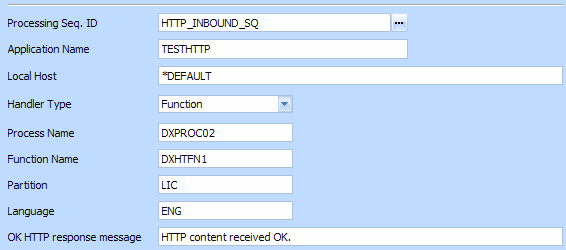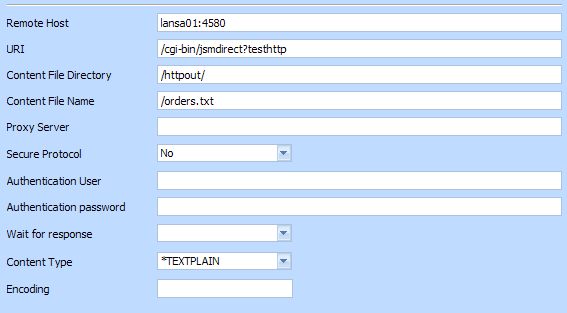2.3.3 HTTP Configuration
The HTTP Configuration may be used to set details of how you wish to send and retrieve payloads using the http protocol. Activities to make use of these Configurations are provided. These are:
- HTTP_INBOUND for inbound HTTP requests
- HTTP_GET and HTTP_POST for outbound requests
Information for an HTTP Configuration is in two parts:
- Identification – Identifies the HTTP Configuration and contains basic information.
- Details – Specific details relating to the type of HTTP Configuration being set up.
Identification
This identifies the HTTP Configuration and contains basic information.

|
HTTP Configuration ID |
An identifier to uniquely identify this Configuration |
| Description |
This should describe the Configuration. |
| HTTP direction | |
| Configuration Status |
Active or Inactive. Configurations cannot be used in a processing sequence while they are in inactive status – supplied activities will end in error if they attempt to use a configuration that has inactive status. |
Details
The details section will vary according to the HTTP direction specified in the Identification section.
The Inbound HTTP Configuration will set up details for a JSMDirect inbound HTTP. The information entered will create and maintain the function registry used by JSMDirect. This is the DC@W29 table on IBM i or the dc_w29.txt on Windows.
Also the Processing Sequence which is to be launched is entered.

|
Processing Sequence ID |
This must contain the Identity of a Processing Sequence. This Processing Sequence should contain an Activity which will process the payload of the inbound HTTP transmission. A standard Activity HTTP_INBOUND is provided for this purpose. |
| Application Name |
This is the application name which will be registered on the DC@W29/dc_w29.txt table. |
| Local Host |
This is the host name which will be registered on the DC@W29/dc_w29.txt table. |
| Handler Type |
Select from Function or IBM i 3GL. |
| OK HTTP response message |
This optional entry may contain the text which is to be sent for an OK response |
For a Handler Type of Function:
|
Process Name |
This must be the process which contains the Function specified in the following parameter. This defaults to DXPROC02. |
| Function Name |
This is the function that will be invoked by JSMDirect when an inbound HTTP transmission with the specified Application Name in the URL is received. |
| Partition |
This must be the LANSA partition which contains the function to be invoked. |
| Language |
This must contain the LANSA execution language. |
For a Handler Type of IBM i 3GL:
|
3GL Program |
This should contain the program name when a Handler Type of IBM i 3GL is selected. |
The outbound HTTP Configuration is for use in an Activity which sends HTTP requests to a remote HTTP server .
If applicable, the payload is specified as a directory path plus the file name of the content file. The content type may also need to be specified.

|
Remote Host |
This must contain the remote HTTP server and port. The format is host:port If the port is not supplied, it will default to 80. |
| URI |
This must contain the remainder of the URI to be used to connect to the remote server. |
| Content File Directory |
Enter the local directory path which contains the content file. You can click the prompt button to browse for a folder location on the LANSA Composer server. |
| Content File Name |
Enter the content file name. This file will be used as the payload of the HTTP transmission. |
| Proxy Server |
If a proxy server is being used, enter the proxy server name. |
| Secure Protocol |
Select Yes to use HTTPS (secure protocol) for the HTTP connection. Select No to use use standard HTTP protocol. |
| Authentication User |
If authentication is required, this contains the basic authentication user. |
| Authentication password |
If authentication is required, this contains the password which is used with the Authentication user. |
| Wait for response |
Select from Yes or No. Select yes if you want the HTTP connection to wait for a response. |
| Response timeout |
If you specified Yes for the Wait for response, then this field can specify a timeout for the response wait, in milliseconds. For example, specify 5000 for a timeout value of five seconds. If zero (or a negative value) is specified, then no response timeout applies. |
| Connection timeout |
This field can specify a timeout for the host connection to be established, in milliseconds. For example, specify 5000 for a timeout value of five seconds. If zero (or a negative value) is specified, then no connection timeout applies. |
| Content Type |
You may select the content type of the payload which will be sent: |
|
*XML |
application/xml |
|
*TEXTXML |
text/xml |
|
*TEXTPLAIN |
text/plain |
|
*SOAP |
application/soap+xml |
|
*HTML |
text/html |
|
*XHTML |
application/xhtml+xml |
|
*CSV |
application/comma-separated-values |
|
*TEXTCSV |
text/ x-comma-separated-values |
|
*TSV |
application/comma-separated-values |
|
*TEXTTSV |
text/ x-tab-separated-values |
|
*X12 |
application/edi-x12 |
|
*EDIFACT |
application/edifact |
|
*STREAM |
application/octet-stream |
|
|
application/pdf |
|
*JSON |
application/json |
|
*EXCEL |
application/vnd.ms-excel |
|
*ZIP |
application/zip |
|
*GIF |
image/gif |
|
*PNG |
image/png |
|
*JPEG |
image/jpeg |
|
*MPEG |
audio/mpeg |
|
*MPEG4 |
video/mpeg4 |
|
|
Most often, however, you may leave the default Automatic setting, which will result in the HTTP_POST activity setting an appropriate content type according to the file extension of the file being sent. (This is achieved by a lookup on the file in the <> directory of the server's JSM instance directory tree.) |
|
Encoding |
You may enter an encoding which will be used to convert the content to Unicode. |
Note: A Test button can be used to check the validity of the parameters for Outbound HTTP Configuration. The parameters tested are: Remote Host, Proxy Server, Secure Protocol, Authentication User and Password, and Connection and Response timeout values, if applicable.